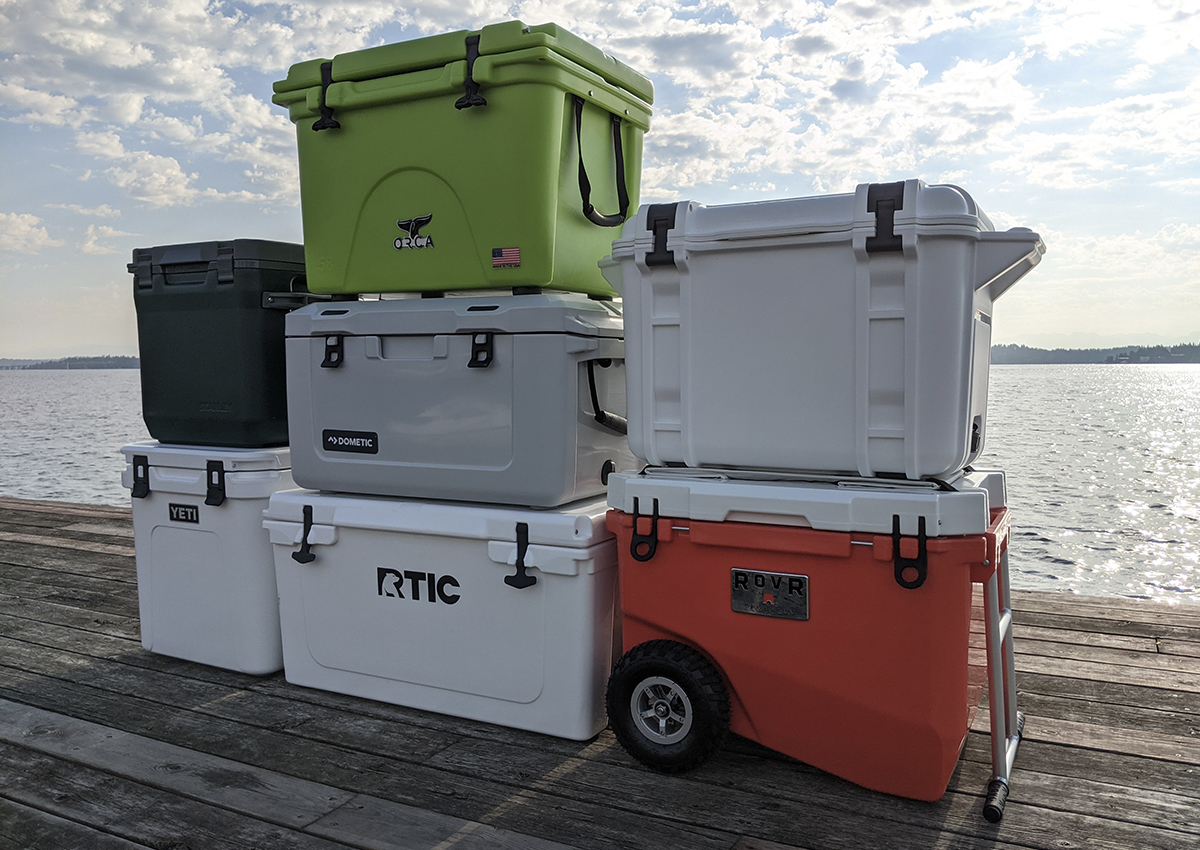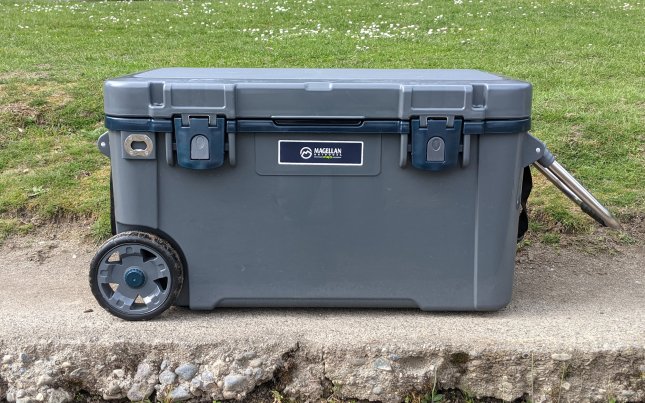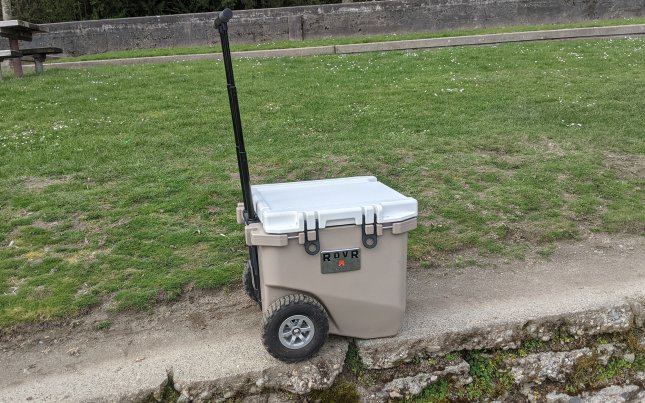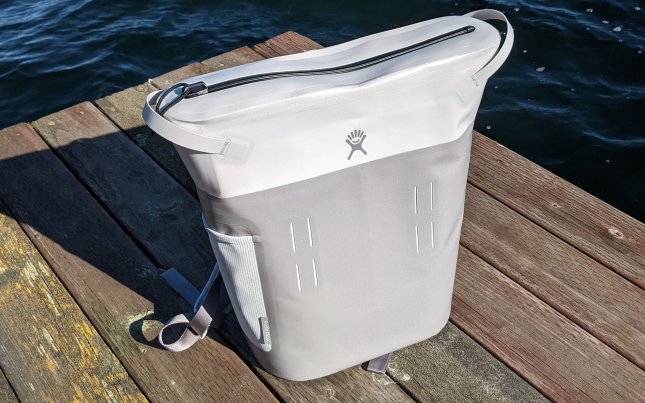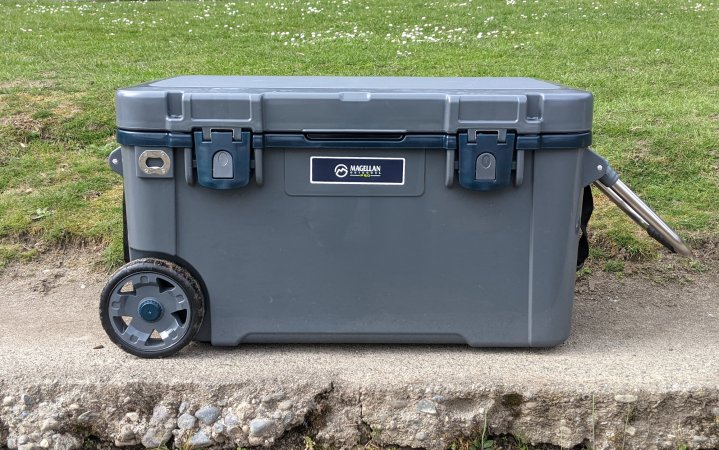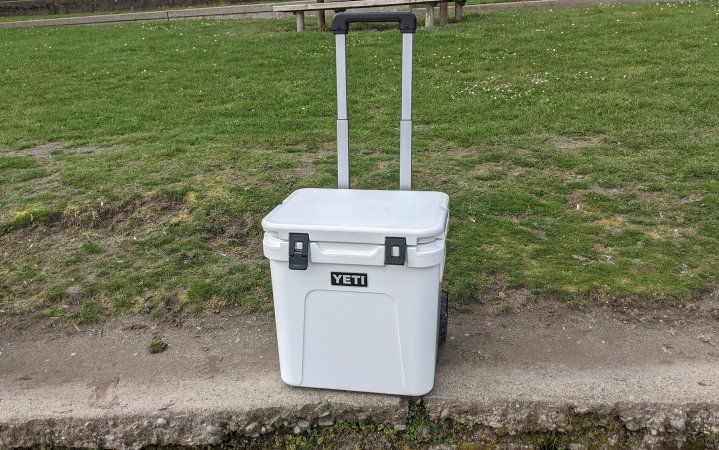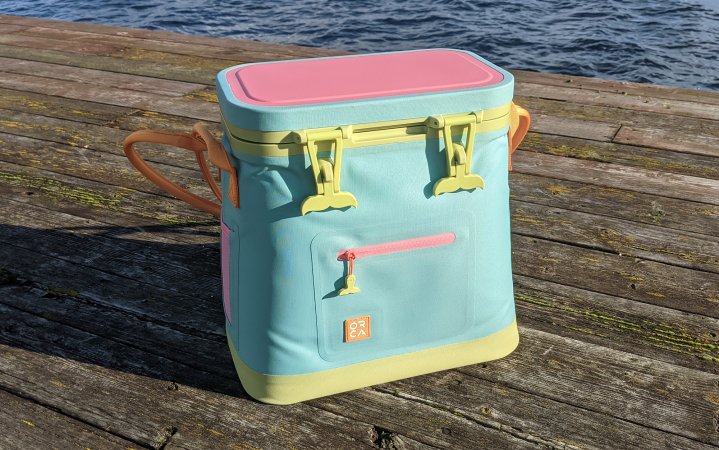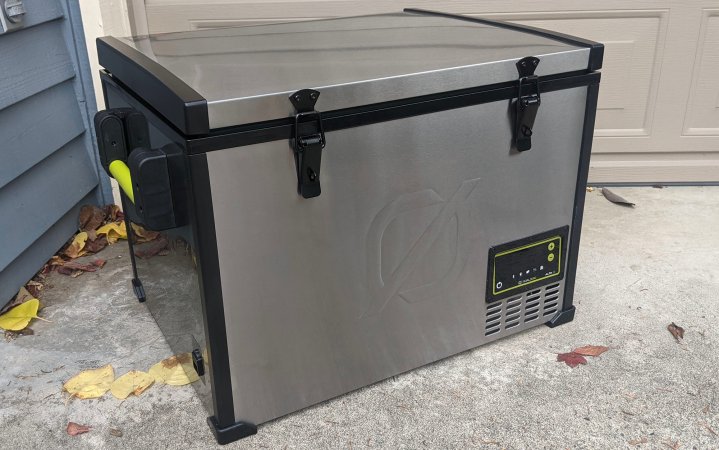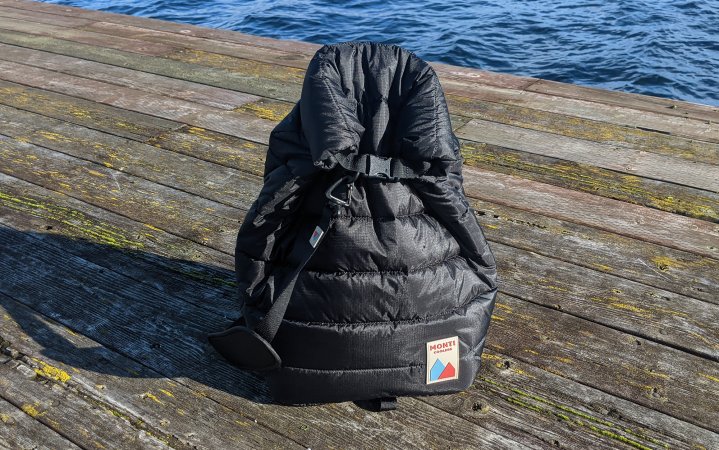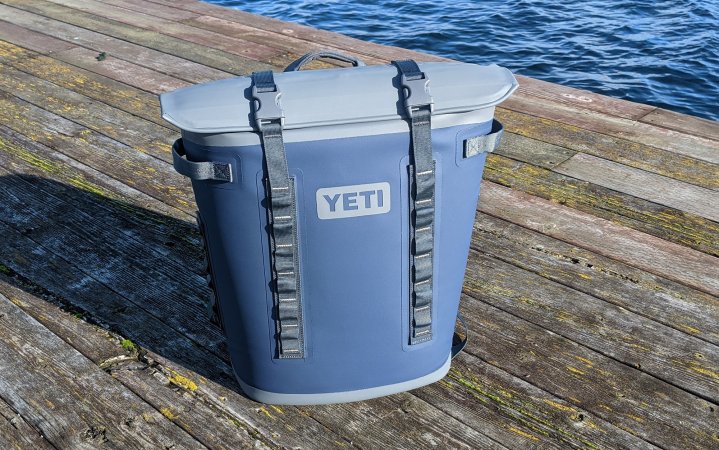We may earn revenue from the products available on this page and participate in affiliate programs. Learn More ›
Over the years I’ve tested dozens and dozens of coolers: Big coolers. Small coolers. Backapck coolers. Electric coolers. One thing I’ve learned is that there is a shocking difference in quality between the best coolers and those that are just ho-hum. But also that price is not always a great indicator of quality, with relatively unknown brands often impressing me more than those that are household names. Here are my top picks, across a variety of categories, for the best coolers.
Best Overall: Magellan Outdoors Pro Explore Icebox 45-QT
↓ Jump to Review
Best Upgrade: Yeti Roadie 48
↓ Jump to Review
Best Wheels: RovR RollR
↓ Jump to Review
Best Small: ORCA Wanderer Tote
↓ Jump to Review
Best Electric: Goal Zero Alta 50
↓ Jump to Review
Best Backpack: Hydro Flask Day Escape
↓ Jump to Review
Most Packable: Monti Shasta
↓ Jump to Review
RTIC Ultra-Light Cooler
↓ Jump to Review
Stanley Adventure Cold for Days
↓ Jump to Review
Yeti Hopper M20
↓ Jump to Review
How I Tested the Best Coolers
Over the last two years I’ve tested over three dozen coolers across a range of criteria. I’ve tested ice retention by filling a half dozen coolers with a bag of ice each and then seeing how long it took to melt.

I tested waterproofness by filling them with water and then tipping them upside down. Portability has been tested in a number of ways, including wheeling coolers across sandy beach or hauling full-size models up and down stairs.

I tested the energy efficiency of electric coolers, and did a deep dive into potential safe savings compared to best-in-class rotomolded coolers over the long haul.

And I’ll be continuing to test coolers in new and existing categories as time goes on. Read more about the testing protocol and other products tested in the following stories:
- The Best Wheeled Coolers
- The Best Camping Coolers
- The Best Small Coolers
- The Best Soft Coolers
- The Best Backpack Coolers
- The Best Electric Coolers
Best Coolers: Reviews & Recommendations
Best Overall: Magellan Outdoors Pro Explore Icebox 45-QT
Pros
- Second longest ice retention in my test
- Excellent haul handles
- Easy to use latches that open on both sides
- Affordably priced
Cons
- The least comfortable to drag across the testing terrain
Key Features
- Weight: 30 pounds
- Capacity: 45 quarts
- Warranty One year
Test Results
- Time to Melt 7 Pounds of Ice: 73 hours
- Ease of Use: Great
- Wheel Performance: Poor
While I originally tested the Magellan Outdoors Pro Explore Icebox as part of my look at the best wheeled coolers, I came away impressed with its ice retention potential relative to its cost, and the thoughtfulness of its features. Simply put, this relative no-name in the world of coolers is one of the best of the best.
During testing, it took over three days for a single bag of ice to melt. The Magellan Outdoors Pro Explore also has excellent haul handles — one of the only coolers of its size I’ve tested that was comfortable to carry up and down stairs or haul it up into my SUV. The latching mechanisms were easy to use and, unusually, were on both sides of the cooler so you could open it from either direction. But the real clincher here is the price: this one is half the price of coolers from higher-end brand names.

The only thing I didn’t love about this cooler were the wheels. This one was a chore to pull across sand, and was pretty wobbly when I brought it down a short series of steps. The haul handle is also shorter than I prefer.
Best Upgrade: Yeti Roadie 48
Pros
- Easy to maneuver over all manner of terrain
- Latching and telescoping handle work seamlessly
- Good warranty
Cons
- Expensive
- Didn’t hold ice as long as other coolers that I tested
Key Features
- Weight: 28 pounds
- Capacity: 76 pounds
- Warranty: Five years
Test Results
- Time to Melt 7 Pounds of Ice: 62 hours
- Wheel Performance: Great
- Ease of Use: Great
The Yeti Roadie 48 is the cooler that has stayed in my gear closet after years of testing. That’s because it ticks all the boxes: good ice retention, easy to use, and very portable. The interior has plenty of space for all my perishables (and a few beers), and mush-able items like butter and cheese slide into the tray on top. I’ve even found that it fits in the back seat of my adventure vehicle (a Toyota 4runner), even when my kid’s car seat is strapped into the middle of the bench.
Read Next: RTIC vs Yeti: Is a More Expensive Cooler Actually Worth It?
In my test of wheeled coolers it came in second for portability only to the RovR RollR, while still being easier to use as an actual cooler (simple latching mechanisms help here). While I wish it had done a little better on the ice retention test, its actual capacity relative to its performance was impressive. More insulation would have meant either a bulkier cooler or less interior space.

The downside to this Yeti is the same downside with just about everything Yeti makes: It’s really expensive. If this one is too rich for your blood, go with my best overall pick, which was also a standout performer.
Best Wheels: RovR RollR
Pros
- Best in class wheels that can handle anything
- Good ice retention
Cons
- Difficult to use latching mechanism
- Shorter warranty despite higher price point
Key Features
- Weight: 37 pounds
- Capacity: 45 quarts
- Warranty: One year
Test Results
- Time to Melt 7 Pounds of Ice: 69 hours
- Wheel Performance: Excellent
- Ease of Use: Good
If you’re planning to wheel your cooler a quarter mile across a rocky beach there’s no question which one you need: the RovR RollR. These are serious wheels, more akin to what you’d see on your fat-tire bike than the typical plastic pieces. And the telescoping handle is both sturdy and lengthy, which dramatically increases leverage. This cooler practically bounced down the steps in my testing circuit for the best wheeled coolers and was equally smooth pulling across both sand and mud.

While the RovR RollR did a great job retaining ice during that portion of testing, it does have a smaller capacity relative to its overall size. It’s also heavier. If you’re packing up the family car for a long weekend of camping, when ever square inch counts, this might be overkill.

I was also a little frustrated by its latching mechanism. While very secure (this one is very close to being waterproof), you do need to use some serious torque. Young children will not be able to open and close this cooler on their own, and a fair number of adults may just not bother.
Read our full best wheeled coolers test to see more options.
Best Small Cooler: ORCA Wanderer Tote
Pros
- Great ice retention
- Easy to use latch
- Waterproof
- Fun color options
Cons
- Doesn’t pack down
- Slightly less capacity than other models I looked at
Key Features
- Capacity: 15 liters
- Weight: 6.3 pounds
- Warranty: Three years
Test Results
- Waterproof: Great
- Latch: Excellent
- Carry Comfort: Fair
- Time to Melt 7 Pounds of Ice: 60 hours
The Orca Wanderer Tote was easily top of the field in my test of the best small coolers. It had excellent ice retention, coming in a close second to the Brumate MagPack. It took 60 hours for 7 pounds of ice to completely melt at room temperature (68 to 72 degrees). That kind of performance tells me that not only is this cooler going to keep everything cold for your day at the beach, it’s also equipped for a weekend car camping getaway. That’s impressive for a soft cooler.
But the ice retention wasn’t the only thing I loved about the Orca Wanderer Tote. I was very impressed by the latching system. Along with the Yeti Hopper M20, these are some of the easiest latches to use across all of the tests I’ve done, which is important when you’ve got other people going in and out of your cooler all day. Even better, when latched, this cooler was fully waterproof. While this cooler doesn’t pack down at all, and wasn’t as comfortable to carry as other soft coolers I looked at, it’s still miles better than a traditional hard-sided cooler. If you’re looking for a soft-sided cooler to round out your hot-weather arsenal, the Orca Wanderer Tote should go to the top of your list.
Best Overall: Goal Zero Alta 50
Pros
- Easy to use and intuitive controls
- One of the more energy efficient models that I tested
- The larger version can be used as a fridge and freezer simultaneously
Cons
- Can’t see the sleek exterior when you use the cover
Key Features
- Price $800
- Weight 49.4 pounds
- Compartments 2 (1 zone)
- Temp Range -4° F to 68° F
- Voltage 12/24 DC or 100/240V AC
- Additional Features Insulated cover, two baskets, DC and AC cables, EU-style AC cable, and app enabled
- Additional Sizes Alta 80
Test Results
- Time to Reach 0° F: 51 minutes
- Energy Draw to Reach 0° F 30 watt hours
- Total Energy Draw after 4 Hours 90 watt hours
- Capacity 64 cans (tested), 75 cans (claimed)
While the vast majority of coolers on the market use good old-fashioned ice to keep your perishables from perishing, electric coolers have become increasingly popular with folk who either need better precision when they are out in the backcountry, or who have access to a quality solar generator setup. I tested six different models to see how quickly they could reach freezing temps and how much power they used in the process.
Read Next: The Best Electric Coolers
As luck would have it, a bomb cyclone took out the power in my house they day after I finished my testing. Out of an abundance of caution, we decided to transfer the contents of our freezer to one of the models I had tested, using one of the best portable power stations to keep it going overnight. At this point, my pick for this was clear: the Goal Zero Alta 50.

There were a few reasons for this. I knew from testing that it was very energy efficient, which is great when you don’t know how long you’re going to need the cooler for. I also liked that it was easy to use, with clear, simple controls without a lot of fanfare.

Our power came back on in the middle of the night, but the cooler was still going strong when I checked on it in the morning, and everything inside was still frozen. I tested the Alta 50, but the Goal Zero Alta also comes in a larger size (the Alta 80) that would allow you to use it as both a fridge and a freezer. Like other coolers, this one comes with an app that would allow you to remotely check, or even change, the temperature.
Best Backpack: Hydro Flask Day Escape

Pros
- Very comfortable to carry (for a backpack cooler)
- Waterproof
- Mesh pocket
Cons
- Not the best ice retention
Key Features
- Capacity: 20 liters
- Weight: 2.6 pounds
- Warranty: Five years
Test Results
- Waterproof: Great
- Latch: Good
- Carry Comfort: Great
- Time to Melt 7 Pounds of Ice: 37
In my experience, the utility of a backpack cooler is somewhat limited. You have to be going a long enough distance that a regular soft-sided cooler isn’t going to be particularly comfortable. But these aren’t really suitable for a hike, either. Backpack coolers are first and foremost coolers, with the backpack element being a bit of an afterthought. Maybe some day Osprey will bless us with a true backpack cooler, but until then we will work with the best that we’ve got.
And that’s the Hydro Flask Day Escape. This is what I would choose if I had to carry a few six packs more than 50 yards. (But I would not want to carry it more than a half mile.) What gives it the edge over other backpack coolers is that it has a wider frame, with less depth, which holds the weight closer to your body than models that were free form or structured like a traditional cooler.

One feature common to backpacks but not to backpack coolers that the Day Escape included was a haul handle, which is handy for at-home storage.
Most Packable: Monti Shasta
Pros
- Packs down very small
- Great ice retention
- Affordably priced
Cons
- Prone to condensation (although otherwise waterproof)
- Lack of structure means it’s easier to tip over and can have knobby bits when fully packed
- Sling style strap is less comfortable for long distances than traditional backpack straps
Key Features
- Capacity: 23 liters
- Weight: 0.9 pounds
- Warranty: None
Test Results
- Waterproof: Fair
- Latch: Good
- Carry Comfort: Good
- Time to Melt 7 Pounds of Ice: 55 hours
If you’re looking for a small cooler to save on space, then the Monti Shasta is the one for you. The exterior pocket doubles as a stuff sack for the rest of the cooler, which reduces the size down to 9 by 8 inches. Prior to testing I guessed this would negatively impact its performance in the ice retention test, not so. It was tied with the Yeti Hopper M20, taking 55 hours for 7 pounds of ice to melt. Even better: You have the option to use the rolltop to squeeze the excess air out of the small cooler when in transit, which should up its performance even more. This is a great, space-saving cooler with a unique design at a good price.

After the first day of testing, I noticed some moisture on the exterior of the Monti Shasta. At first I thought it was leaking, but the limited amount of wetness over the course of two and a half days of testing suggests this was something else: condensation, a lot of condensation. Once you figure out what’s going on, it’s not a problem, but expect there to be a small wet spot wherever this cooler is sitting. Though, during testing, the zip and roll-top closure proved to be completely waterproof. It’s also worth noting that due to its design, this small cooler doesn’t have the structure of the other options in this story. It sits upright just fine, but will be more prone to tipping.
RTIC 52-QT Ultra-Light Cooler
Pros
- Affordably priced
- Very lightweight for its size and performance
Cons
- Not as good ice retention as other things I looked at
Key Features
- Weight: 21 pounds
- Capacity: 52 quarts
- Warranty: Three years
Test Results
- Time to Melt 7 Pounds of Ice: 55 hours
- Wheel Performance: Good
- Ease of Use: Good
While I was pleasantly surprised during testing at just how lightweight the RTIC Ultralight is, for most people, I don’t think this feature outweighs its so-so performance when it comes to actually keeping things cold.

Snag this one if you only go out for shorter outings, or keep your empty cooler stored in a high up, hard to get to place.
Stanley Adventure Cold for Days
Pros
- Inexpensive
- Streamlined design works well for smaller cars
Cons
- May not have enough storage space for longer adventures
Key Features
- Weight: 13.6 pounds
- Capacity: 30 quarts
- Warranty: Three years
Test Results
- Latching Mechanism: Good
- Time to Melt 7 Pounds of Ice: 64 hours
For campers that have a sedan as their primary vehicle (that was me for years), a 3-foot long cooler capable of storing enough of the best camping meals for a family of six for a week is frankly overkill. A family of four would find the Stanley Adventure Cold for Days is the perfect size for a weekend trip with plenty of room to stash snacks for the kids and adult beverages for the parents. Two people would have plenty of room for a longer getaway.
This cooler held its own during the ice retention test. Impressive as the Stanley Adventure for Days Cooler is, it was one of the few in my test that isn’t rotomolded (considered by many to be an industry standard in the best camping coolers). But it also had several features that I appreciated, including a fairly simple click latching system (no difficulty in managing the rubber latches here). I also liked that the drainage port cap was connected to the rest of the cooler, making it harder for forgetful campers (i.e., me) to lose it over the long haul.
But perhaps the biggest draw of this camping cooler is its significantly lower price point, a third the cost of the highest-priced cooler in my test of the best camping coolers. If you’re just getting started camping with your friends or significant other, then this is an excellent choice that will last you for years.
Yeti Hopper M20
Pros
- Great ice retention
- Excellent latch
- Waterproof
Cons
- Expensive
- Shoulder straps are a little stiff to start
Key Features
- Capacity: 20 liters
- Weight: 4.5 pounds
- Warranty: Three years
Test Results
- Waterproof: Great
- Latch: Excellent
- Carry Comfort: Good
- Time to Melt 7 Pounds of Ice: 55 hours
Like with so many of their products, Yeti nailed nearly all the details on their Hopper M20 Backpack cooler, but at a cost. This one was over three times the price of my best value pick for the best backpack coolers.
Ice retention was excellent with the Yeti Hopper M20 backpack, tying for third in my test with the Monti Shasta. It also has an unusually excellent latching system. There are two buckles to tie down the roll-top opening for waterproof transport. But when you’re at the beach and your friends are going in and out of the cooler for brews, you won’t have to worry that they forgot to close the cooler, because there is a magnetic closure that is super effective, closing securely with the slightest effort. Check and check. The only real ding (besides price) are the straps, which are a little stiff out of the box, but I expect them to soften up over time.
Things to Consider When Purchasing the Best Cooler
Ice Retention of the Best Coolers
I’ve seen a wide range of ice retention capability in my years of testing coolers, and one thing has become clear: You get what you pay for. In almost all scenarios, the coolers that have the best ice retention have been the most expensive. However, how much ice retention you need personally will vary. If you’re only planning to head out for the day or overnight, you can get away with a less capable cooler than if you need three bags of ice to last for a week or more. Consider your needs before making a final purchase.
Size of the Best Coolers
There are two dimensions you should be concerned with when it comes to coolers: external size and internal size. The external size will need to fit your available storage, both in your home and in your car. The internal size will need to hold sufficient food, beverages, and ice to meet your needs. Consider both dimensions before making a final purchase.
Portability of the Best Coolers
In testing coolers, which typically involves hauling them up and down several flights of stairs and into my car before I even get to a testing site, the details that make for a portable cooler really start to pop. For large, non-wheeled coolers, comfortable haul handles are everything. For wheeled ones, a short handle can make for a miserable experience. Some small coolers sit comfortable against your body when you’re carrying them. Others are awkward and dig into your legs. And, as someone who has tested a number of the best backpacks, I’m still waiting for a backpack cooler that I’d actually want to take on a longer hike.
Latching Mechanism of the Best Coolers
You can maximize the ice retention of your cooler by keeping it closed. That sounds like an obvious point, but how easy the latches are to use can really impact how this plays out in practice, especially when children are involved. If you expect a variety of people to go in and out of your cooler all day, look for latches that are simple and secure, and don’t require a lot of torque.
FAQs
In my testing, only one cooler brand approached the performance level of Yeti: RovR. In fact, I think that cooler has significantly better wheels and is generally more portable than Yeti.
In my years of testing over 30 coolers, the Brumate Brutank held a 7-pound bag of ice the longest: It took over three days for it to fully melt. However, it’s worth noting that this cooler has a similar packed size to coolers with 10 quarts more interior space.
Coolers can cost anywhere from $50 to $500.
Final Thoughts on the Best Coolers
One of the best cooler can really elevate your outdoor experience. The options here are my favorite picks after years of testing dozens of models.
- Best Overall: Magellan Outdoors Pro Explore Icebox 45-QT
- Best Upgrade: Yeti Roadie 48
- Best Wheels: RovR RollR
- Best Small: ORCA Wanderer Tote
- Best Electric: Goal Zero Alta 50
- Best Backpack: Hydro Flask Day Escape
- Most Packable: Monti Shasta
- RTIC Ultra-Light Cooler
- Stanley Adventure Cold for Days
- Yeti Hopper M20
